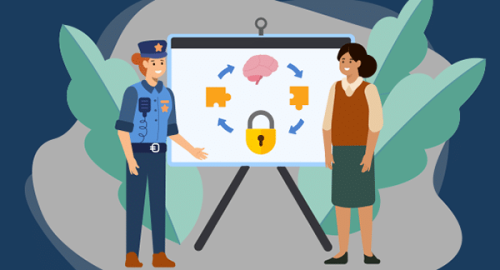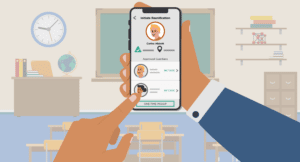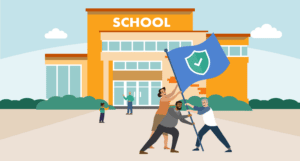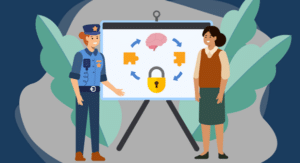Listen to this blog
4 minutes
The earliest days of school safety—following a number of tragic school fires in the early 1900s—focused on reactive practices, evacuating in the event of a fire, for example, or taking shelter in severe weather. While these practices certainly remain relevant, there’s a shift towards enhancing school safety with prevention-focused protocols, including mental health support and technological advancements.
This transformation toward a comprehensive, holistic strategy reflects the impact of societal changes, technological advancements, and legislative updates. We are seeing positive growth in areas such as:
- A shift from reactive to preventive measures, incorporating mental health considerations.
- Strengthening community-school partnerships for collaborative safety efforts.
- Adapting safety plans with flexibility to meet legal and strategic needs.
- An increase in funding for school safety initiatives.
These improvements in safety strategies are critical and powerful—but advancing school safety takes more than stretching new policies and strategies across outdated safety tools and practices.
It’s time we reimagine what the future of school safety looks like—in practice, in the tools we use, and in the people involved.
Reimagining School Safety
This vision moves beyond traditional protocols to incorporate advanced solutions that anticipate and mitigate risks. These technologies, when combined into an integrated platform, offer the promise of a dynamic and responsive safety infrastructure.
Here are 4 key facets of school safety that can be reimagined to improve the safety and security for our students.
Community Involvement
Fostering a culture of safety in schools today means moving beyond traditional boundaries to involve the whole community. By empowering parents, volunteers, and community members, we create a collaborative ecosystem where everyone contributes to safety.
This ecosystem ensures that, even in emergencies, there’s a quick and organized response, reinforcing the safety net for our students.
What does this look like?
- Empower parents and community members to actively participate in keeping schools safe.
- Streamline the experience for school volunteers so they can submit applications and manage their hours in a self-serve platform.
- Reduce the logistics of tracking ticket punches and simplify the process for the community members by enabling them to register for school events and purchase tickets in a dedicated app.
- Connect ticketing workflows with school visitor management. Not only does this enable easy filtering of unsafe individuals, it also improves the visitors’ safety on campus.
Rethinking Visitor Management
Schools are increasingly becoming community hubs above and beyond the role filled in the school day. Providing a venue for sports events, elections, and even severe weather community shelters, schools open their doors to a wide range of community visitors.
Modernizing school safety also requires rethinking visitor management with workflows adaptable across districts, combining the robust security of highly secure industries like banking with the convenience of mobile technology.
What does this look like?
- Identity verification reassures administrators and strengthens school security.
- Parents, volunteers, and community members are empowered to actively engage in safety measures—managing student attendance, changes in dismissal instructions, volunteer hours, and event participation through a dedicated app.
- A streamlined visitor experience that also ensures a high-security standard, crucial for safe school environments.
- Should an emergency occur during an event, modernized visitor management capabilities facilitate swift actions for student and visitor safety and reunification.
Leveraging CPTED for Student Safety and Wellbeing
Bringing the whole educational community together—families, businesses, and school personnel—improves opportunities for collaboration and allows schools to customize their safety plans to their community’s needs. This collaboration aligns with a best practice in violence prevention: Crime Prevention Through Environmental Design (CPTED).
What is CPTED?
CPTED elevates the built environment’s design to minimize chances of conflicts and violence while encouraging favorable conduct.
By carefully evaluating components like lighting, access management, surveillance systems, green spaces, and signage, educational institutions can cultivate a perception of security and markedly enhance safety results. Adhering to CPTED principles deters potential risks and grants students and faculty a comforting feeling of safety.
It does more than just improve physical security—it’s about impacting community culture through controllable circumstances in the campus design.
The implementation of CPTED principles—supported by assessments and guidance from federal agencies—also improves community and student wellbeing.
An internationally-recognized best practice, CPTED focuses on the following principles:
- Enhancing visibility,
- Controlling access,
- Defining ownership / territory,
- Maintaining spaces to signal care and community ownership.
Incorporating CPTED principles into the daily movements of students emphasizes physical security and the school community’s holistic wellbeing. Through strategies that increase visibility into student movement and manage campus access, schools can significantly deter potential threats while promoting a positive, inclusive environment.
Further, expanding and modernizing the means for parents and guardians to update the school about their students nurtures social connectedness. This enhances the school community’s connection and engagement, which in turn encourages positive interactions among students, staff, and local residents.
Connectivity initiatives bridge the school with its wider community, promoting mutual support and engagement. Reinforcing a sense of school pride and unity better aligns everyone towards a shared vision of safety and wellbeing.
What does this look like?
- Parents connect with the school via an app that coordinates and simplifies student dismissal to busses, cars, and after-school activities. This helps verify that students are leaving with safe, approved individuals and monitor student movements across campus.
- Providing further insight into student movement, automated hall passes enhance visibility and accountability for students outside the classroom—and reduce the paper waste of disposable passes.
- School administrators can review the usage to see patterns; this insight can also help determine students who may need support.
- A school safety ecosystem that streamlines access control lockdown with a single action when activating an emergency alert. Using an open API enables native, bi-directional integration that enables that single activation point to also activate technology like access-controlled doors—which means activating a lockdown can automatically secure remotely locking doors.
Two-Way Communication: The Heart of Modern School Safety
At the core of contemporary school safety efforts is two-way communication. This approach ensures that students, staff, parents, and first responders are not merely recipients of information but active participants in the safety ecosystem. By fostering an environment of collaboration and inclusivity, schools can develop a culture of preparedness that encompasses physical, mental, and digital wellbeing.
Ensuring all members of the school ecosystem—students, staff, parents, and first responders—are active contributors, not just receivers, in maintaining safety is a cornerstone to advancing a culture of school safety.
What does this look like?
- Enhanced collaboration with first responders. For example, integrating a 911 workflow to strengthen communication and, in turn, improve emergency response times and facilitate critical data sharing with first responders
- Enabling communication with school community members and visitors during an emergency provides assurance to those in crisis.
- Nurture the connectedness among your staff through two-way communication for localized incidents.
Looking Forward
As we look towards the future innovations in school safety, the narrative is not just about adopting new policies or technologies but fundamentally reenvisioning our approach to safeguarding our educational environments.
It’s about crafting spaces where safety and wellbeing are interwoven into the very fabric of our schools, empowered by community collaboration, innovative management systems, and principles that prioritize holistic wellness. This vision for the future is not just an aspiration but a roadmap guiding us towards a safer, more connected, and resilient educational ecosystem.
Related Resources
Raptor Reimagines the Future of School Safety
New Products Launching in 2024

Listen to this blog
4 minutes







